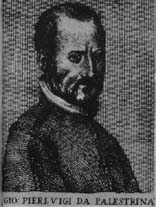

GIOVANNI PIERLUIGI DA PALESTRINA
1525 or 1526 --- 2nd February 1594
© From "Music Through the Centuries" by Nick Rossi & Sadie Rafferty.
Last Updated on 2023
By Steven Ritchie
And now for the Music

Thanks to Rosario Bassi for the music below.
(4058)New "Missa, AEterna Christi Munera, Kyrie, No.1". Sequenced by Rosario Bassi. (4057)New "Missa, AEterna Christi Munera, Gloria, No.2". Sequenced by Rosario Bassi. (4056)New "Missa, AEterna Christi Munera, Credo, No.3". Sequenced by Rosario Bassi. (4055)New "Missa, AEterna Christi Munera, Sanctus, No.4". Sequenced by Rosario Bassi. Thanks to Robert Andreas Austin for the music below.
(2152)"Missa Pape Marcelli (Mass For 6 Voices) Kyrie". Sequenced by Robert Andreas Austin.
(2153)"Missa Pape Marcelli (Mass For 6 Voices) Gloria". Sequenced by Robert Andreas Austin.
(2154)"Missa Pape Marcelli (Mass For 6 Voices) Credo". Sequenced by Robert Andreas Austin.
(2155)"Missa Pape Marcelli (Mass For 6 Voices) Sanctus". Sequenced by Robert Andreas Austin.
(2156)"Missa Pape Marcelli (Mass For 6 Voices) Benedictus". Sequenced by Robert Andreas Austin.
(2157)"Missa Pape Marcelli (Mass For 6 Voices) Agnus Dei I". Sequenced by Robert Andreas Austin.
(2158)"Missa Pape Marcelli (Mass For 6 Voices) Agnus Dei II". Sequenced by Robert Andreas Austin.
Thanks to Emily Gray for the music below. Email (HappyMusician@opendiary.com)
(1875)"Esercizio Sopra La Scala". Sequenced by Emily Gray
(1878)"Ascendo ad Patrem, Motet". Sequenced by Brian M. Ames (1876)"Alma Redemptors Mater". Sequencer Unknown
(1877)"Voi Mi Poneste in Foco". Sequencer Unknown

If you done any Classical pieces of say for example, Delius, mozart, and so on etc,
please email them to the classical music site with details to
"classical (@) ntlworld.com" written this way to stop spammers
just remove spaces and brackets for email address, thank you.

Visitors to this page --

Back to Classical Midi Main Menu click "HERE"